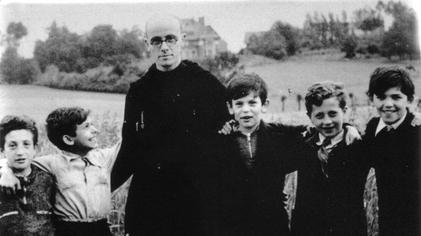In the stillness of monastic walls, he mounted a daring rescue—saving lives when silence would have been easier.
Why His Story Matters Today
When injustice and cruelty rule, the quiet ones become revolutionary. Dom Bruno—Henri Reynders—stood against the Nazi tide not with a sermon, but with a sanctuary. In a world still grappling with divisions and ideological idols, his way of resistance reminds us: loving well often looks like hiding children in plain sight, forging false papers in forgotten corridors, and trusting in unseen courage. His life challenges us to ask: How would we act when speaking the gospel itself becomes an act of resistance?
His Story, His Journey
Born in 1903 in Belgium, Henri Reynders entered the Benedictine Mont-César Abbey, taking the name Dom Bruno. He earned a doctorate in theology and was seen as intellectually daring—even challenging his abbey with Lutheran theological ideas, a bold move in traditional monastic circles.
While lecturing in Nazi Germany, he witnessed the brutality of antisemitism firsthand—calling it “shocking, revolting, and nauseating.” That experience marked him deeply and lit the fuse for what would become a quiet but dangerous path of moral resistance.
World War II would reshape his vocation.
In 1940, he served as an army chaplain in the Belgian military. He was captured by German forces and spent several months as a prisoner of war before being released and returning to the abbey.
Once home, Dom Bruno joined the Belgian Resistance. He began by helping downed British pilots escape the occupied country, and by 1942, he had turned his full attention to rescuing Jews, particularly children, who were being rounded up for deportation and extermination.
Using his connections, intelligence, and monastic mobility, Dom Bruno created a secret network of hiding places—Christian homes, convents, orphanages, and monasteries. He accompanied many of the children himself, providing forged identification and ration cards, and carefully choosing the people he trusted to hide them. His rescues were deeply personal and pastoral.
Even after the Gestapo raided his abbey in 1944, Dom Bruno continued his work in hiding, disguising himself and traveling by bicycle to deliver documents and relocate children. He became a courier of hope, slipping past checkpoints with God’s grace and great courage.
After the liberation of Belgium, Dom Bruno worked tirelessly to reunite children with their surviving family members. Where families had been lost, he approached questions of religious identity with pastoral sensitivity—never forcing conversion, but respecting each child’s heritage and trauma.
In 1964, Yad Vashem named him Righteous Among the Nations, an honor given to non-Jews who risked their lives to save Jews during the Holocaust. Today, his name is remembered in Belgian public squares, and his legacy is etched into the walls of Yad Vashem’s Garden of the Righteous.
Faith Anchored in Action
Dom Bruno never saw rescue as optional. His theology didn’t separate doctrine from deeds. In his life—driven by compassion and risk—faith took shape as creative defiance.
His resistance wasn’t a banner—it was a bicycle ride through danger. It was hiding children where no one expected to look. His love didn't parade; it hid—but never ceased.
Call to Courage: Faith That Hides and Holds
Discern True Allegiances
→ Is our faith anchored in institutions or incarnational love?
Dom Bruno taught that faith hidden in holy homes can resist empires without marching through them.
Embrace Sacrificial Love
→ What hidden act of love can cost yet save?
Dom Bruno risked his entire life—not to be a hero—but to protect the vulnerable. What are the quiet choices we can make today?
Act Concretely
→ How are we hiding the wounded and amplifying the small daily rescue God places before us?
For Dom Bruno, writing papers, forging names, and offering sanctuary weren’t extra—they were gospel incarnate. What does that look like in your context?
Support Hidden Heroes
→ Who risks quietly? Let’s stand with them—share their stories, protect their witness.
Real courage is often invisible. Let’s lend our voice to their silent love.
More Light for the Journey
Micah 6:8 – “Do justice. Love mercy. Walk humbly with your God.”
Matthew 25:40 – “…as you did it to one of the least of these, you did it to me.”
1 John 3:18 – “Let us not love with words or speech but with actions and in truth.”
Hebrews 10:24 – “Let us consider how to stir up one another to love and good works.”
Let’s Walk This Out Together
Dom Bruno’s resistance wasn’t loud—but it was profound. It challenges us to remember: the most revolutionary acts might be done in silence, away from cameras or applause.
In a world driven by spectacle, his life invites quiet courage. We may not save children from the Gestapo, but we can bear witness—in our neighborhoods, faith communities, and workplaces—by choosing what’s right, even when it's hidden and risky.
Share this portrait. Reflect on where grace hides today. Join the conversation: #PortraitInChristianResistance #FaithThatHides #ChristAboveEmpire.
Footnotes
Dom Bruno’s biography and rescue work.Quest for Eternal Sunshine
On rescuing and network formation.Wikipedia
Details of raids and hiding.WikipediaThe Jewish Press - JewishPress.com
Post-war return and recognition.Wikipedia The Jewish Press - JewishPress.com+5






